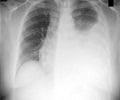Mycobacterium avium that causes tuberculosis, live in macrophages and the well adapted bacteria hide within the cells and spread the infection.

TOP INSIGHT
M. avium not only avoids being killed by macrophages, but even avoids being discovered by them.
This long history has helped the bacterium to become very widespread. One in every three individuals may be hosting this bacterium, and even if only ten percent of them contract the illness, it poses a significant problem.
Causes infections
Tuberculosis bacteria belong to the mycobacterial pathogens. These mycobacteria can cause chronic infectious diseases. It can be both dangerous and difficult to study the tuberculosis bacterium, but CEMIR's new high-risk laboratory now makes such research possible. However, a lot of tuberculosis research is undertaken using the closely related Mycobacterium avium.
This bacterium is far less aggressive and usually only causes problems in birds. It doesn't kill the cell that it hides in, but is dangerous enough that it can cause infections in individuals with an impaired immune system, such as patients who are receiving cancer treatment, who have pre-existing lung problems or whose immune systems are otherwise compromised.
The mycobacteria are essentially stowaways: they live in macrophages, the major cells in our body whose task is to gobble up different enemies, useless cells and other particles. Macrophages are a kind of brutal guard in the service of our bodies.
The phagosome fuses with other vesicles that contain various decomposing substances. It matures and turns into a lysosome. In the lysosome, bacteria are broken into their individual constituents, which can be reused by the body. However, some of the mycobacteria go undetected.
A new study from CEMIR provides new insight into why. The study, led by Professor Flo, has just been published in PLOS Pathogens. Hiding in a separate compartment
Postdoctoral fellow Alexandre Gidon at CEMIR specializes in the use of advanced microscopes. He and his colleagues have studied mycobacteria and macrophages directly through a confocal microscope. Gidon is the first author of the new study.
Their research shows that M. avium not only avoids being killed by macrophages, but even avoids being discovered by them. It is this recognition phase that the CEMIR researchers are now able to shed more light on.
In the beginning, macrophages bind to and sense M. avium, which initiates an inflammatory response, which is key to limiting an infection. But then, the bacterium prevents the phagosome from being converted to a lysosome.
"After M. avium is engulfed by the macrophage, it avoids getting degraded and hides in a separate compartment inside the macrophage, a vesicle, where it is no longer recognized -- the sensors are either not present or else don't react to the presence of the bacteria. This way they can thrive and divide," Flo says.
"How this happens, we don't yet know. But if we could prevent mycobacteria from hiding in this compartment, or force the bacteria out of it, they would have a hard time not being killed. Then it would have trouble causing a chronic infection," she said.
An important lead may be that not all mycobacteria manage to avoid being detected. The macrophages engulf all the bacteria, but only the most well-adapted ones are not discovered and manage to hide and survive.
The researchers envision future research where they would try to find out how the mycobacteria manage to establish and sustain the vesicle hideouts as they evade discovery. That would enable something to be done about these chronic troublemakers.
Better treatment is the goal
The treatment for common tuberculosis usually involves four different antibiotics to start, and gradually decreases to two. The whole process takes about six months. But if the tuberculosis bacterium is resistant to antibiotics, recovery can take up to two years.
"Unlike a number of other infectious diseases, you don't become immune even if you've had tuberculosis. You can become infected and sick again, so it's important to find solutions that can provide milder, shorter-term treatment," says Flo.
Source-Eurekalert
 MEDINDIA
MEDINDIA




 Email
Email










